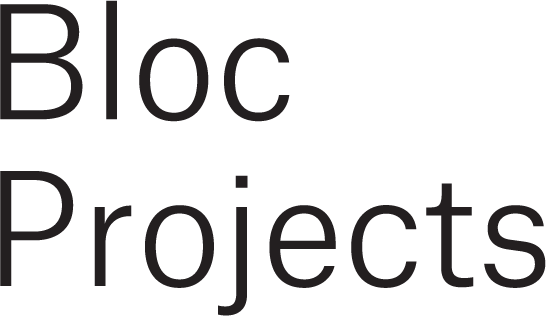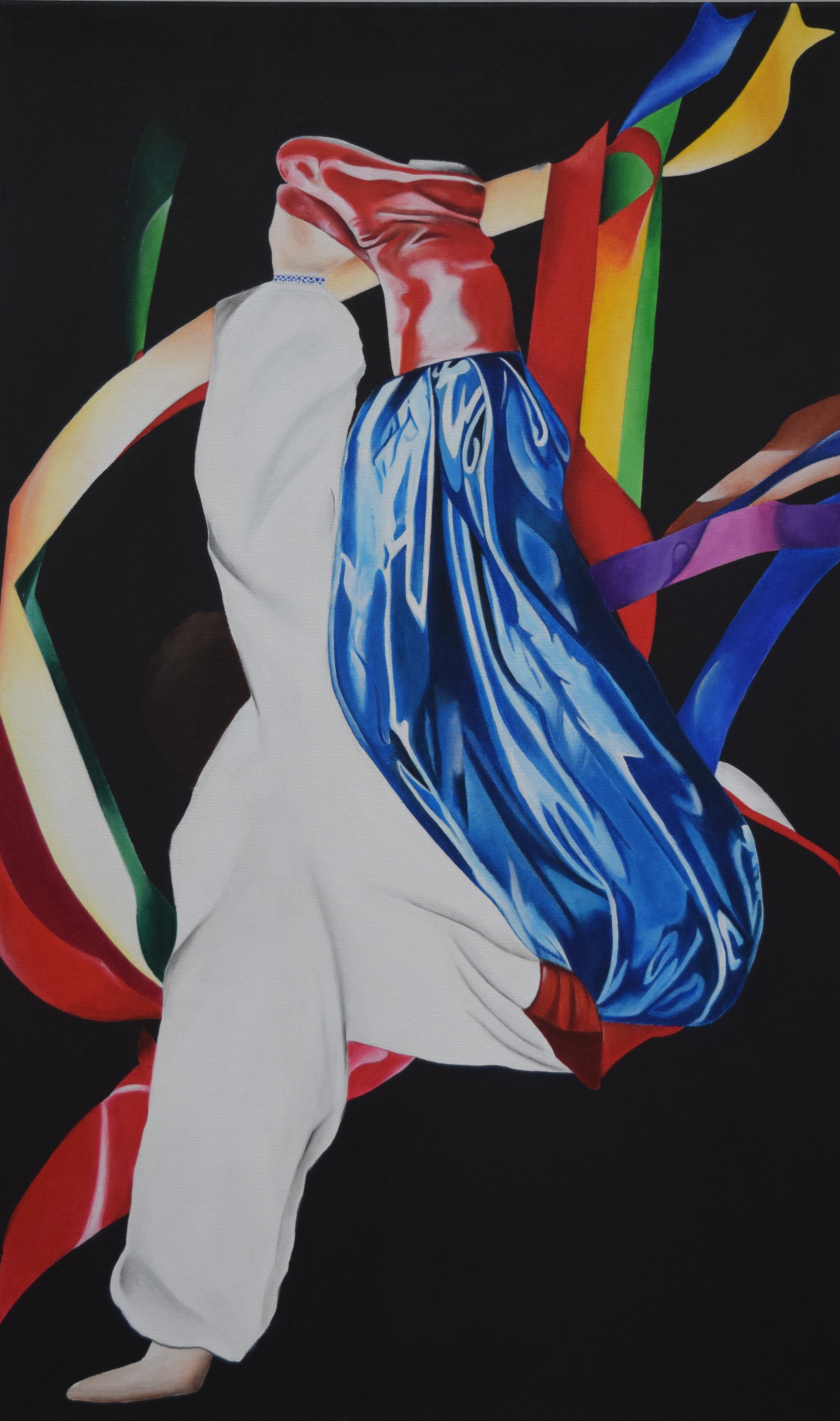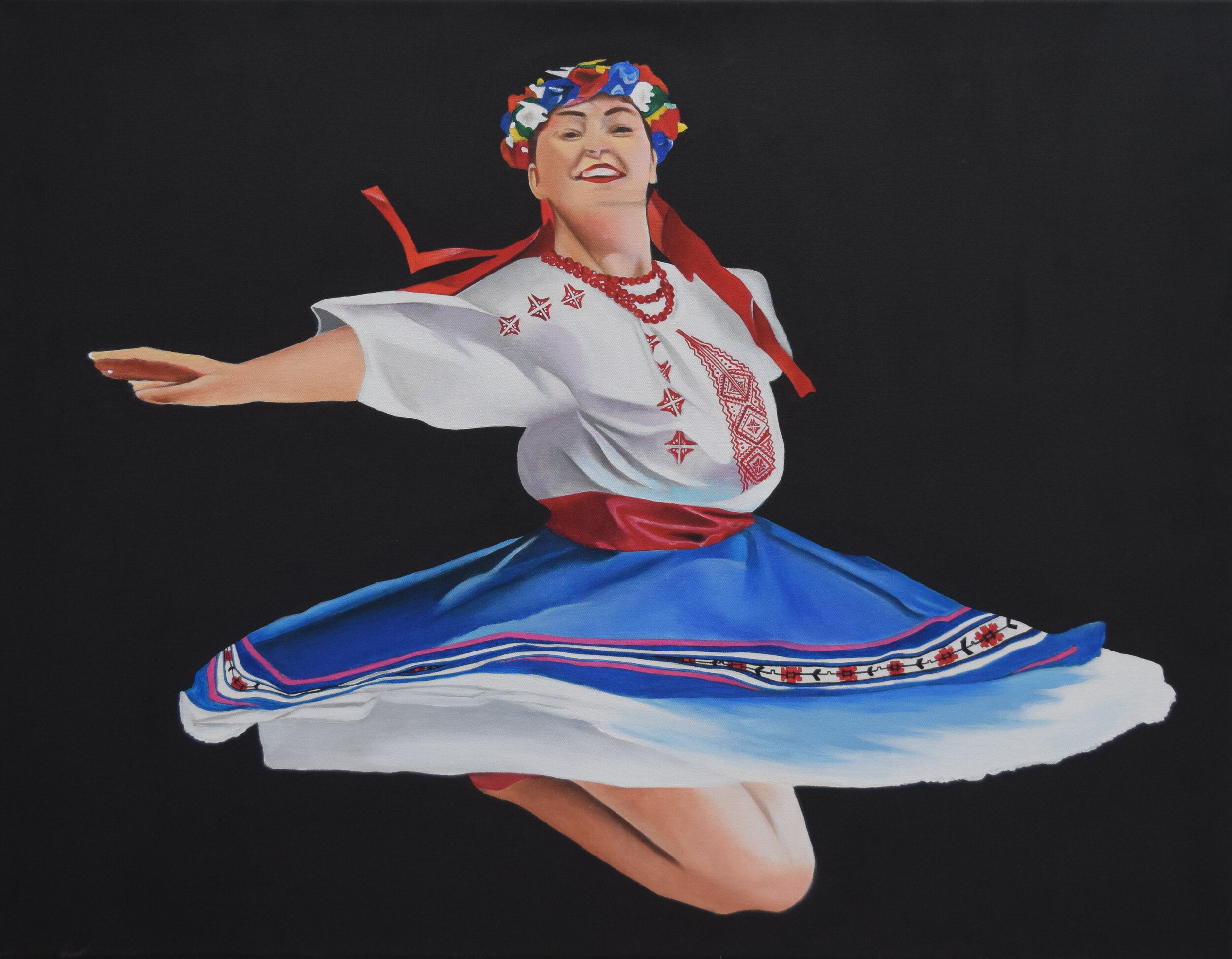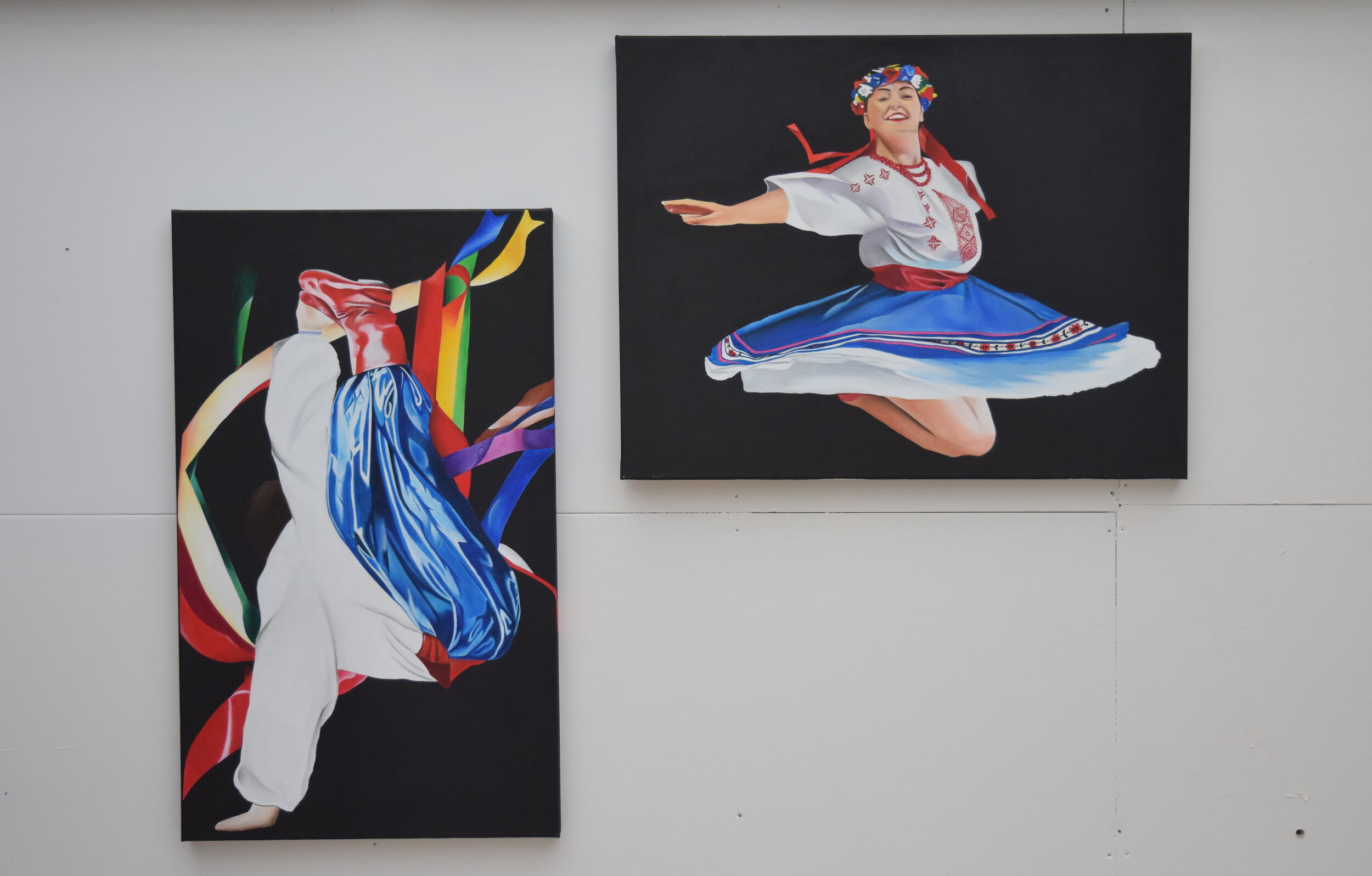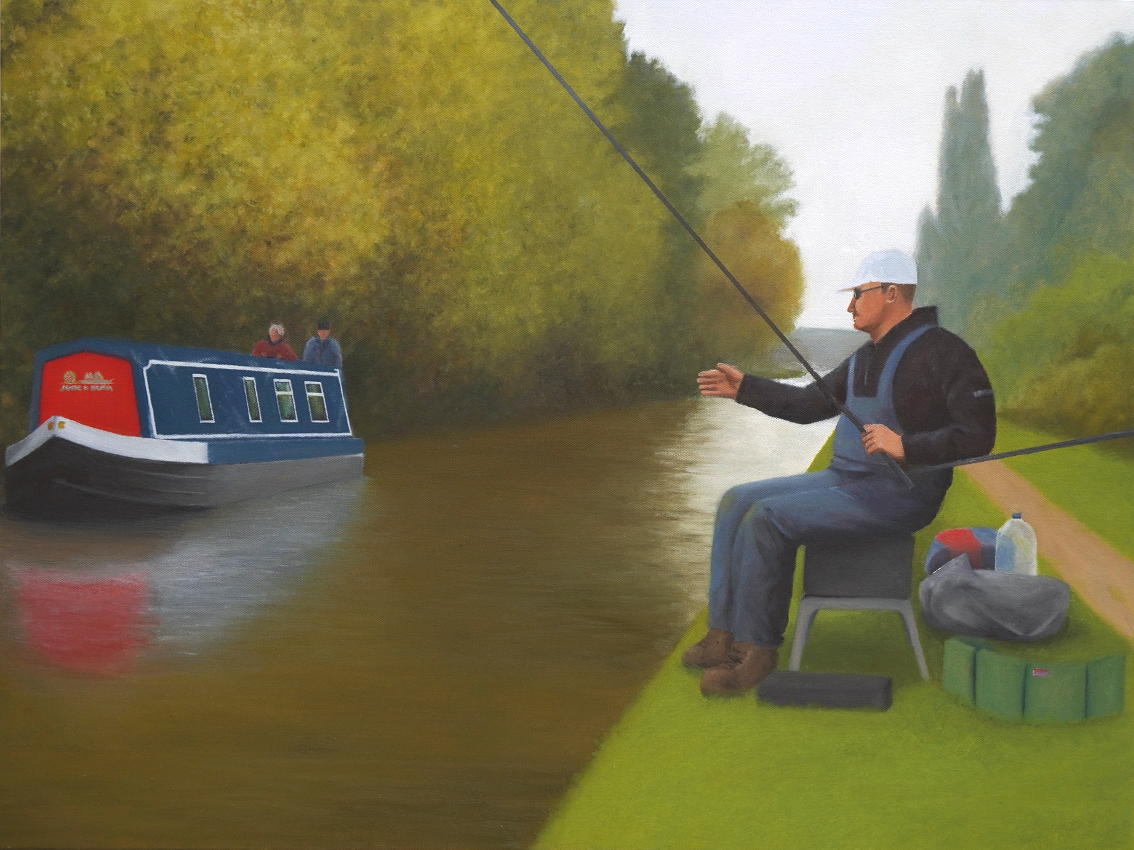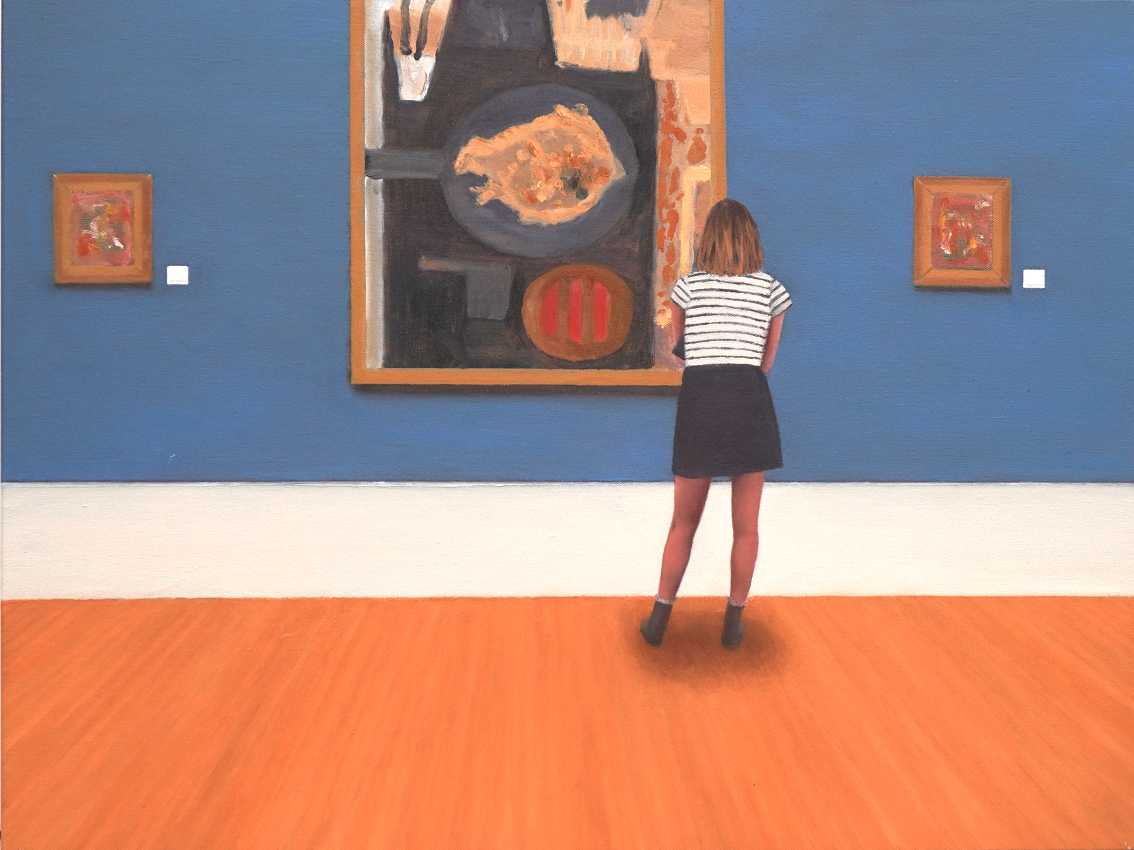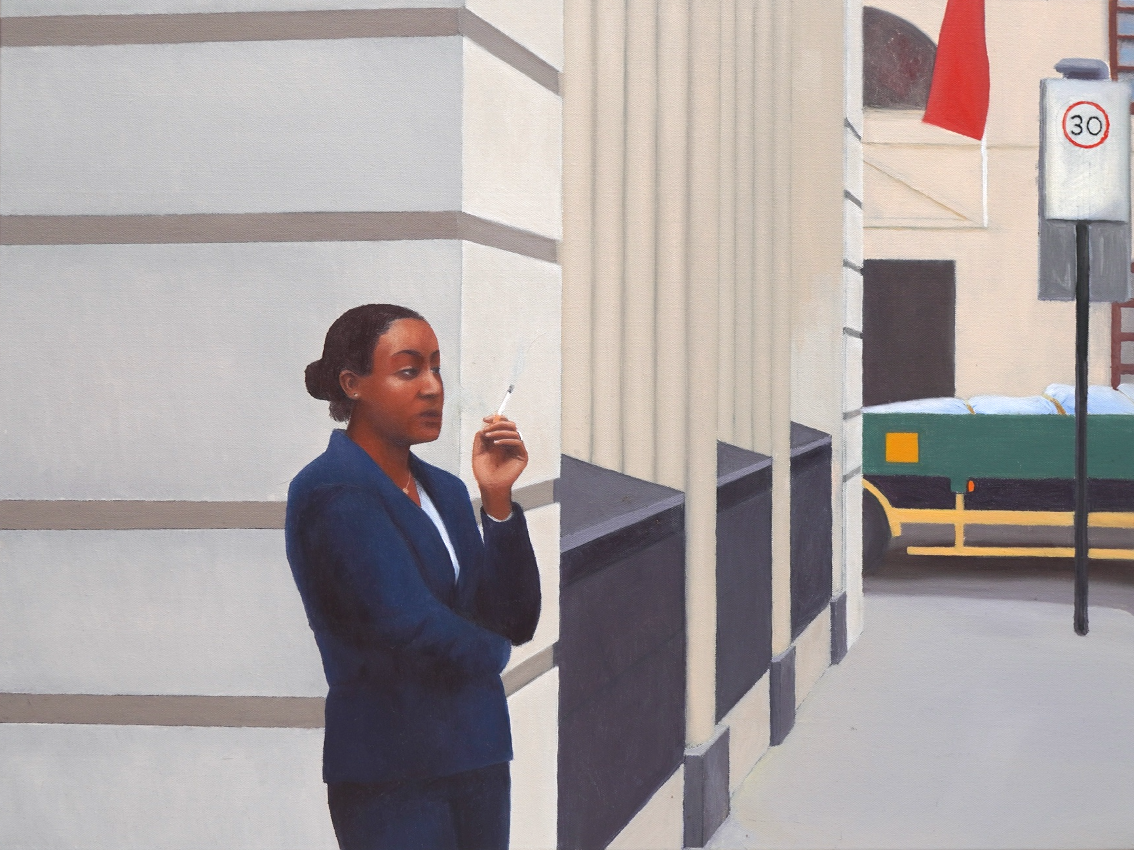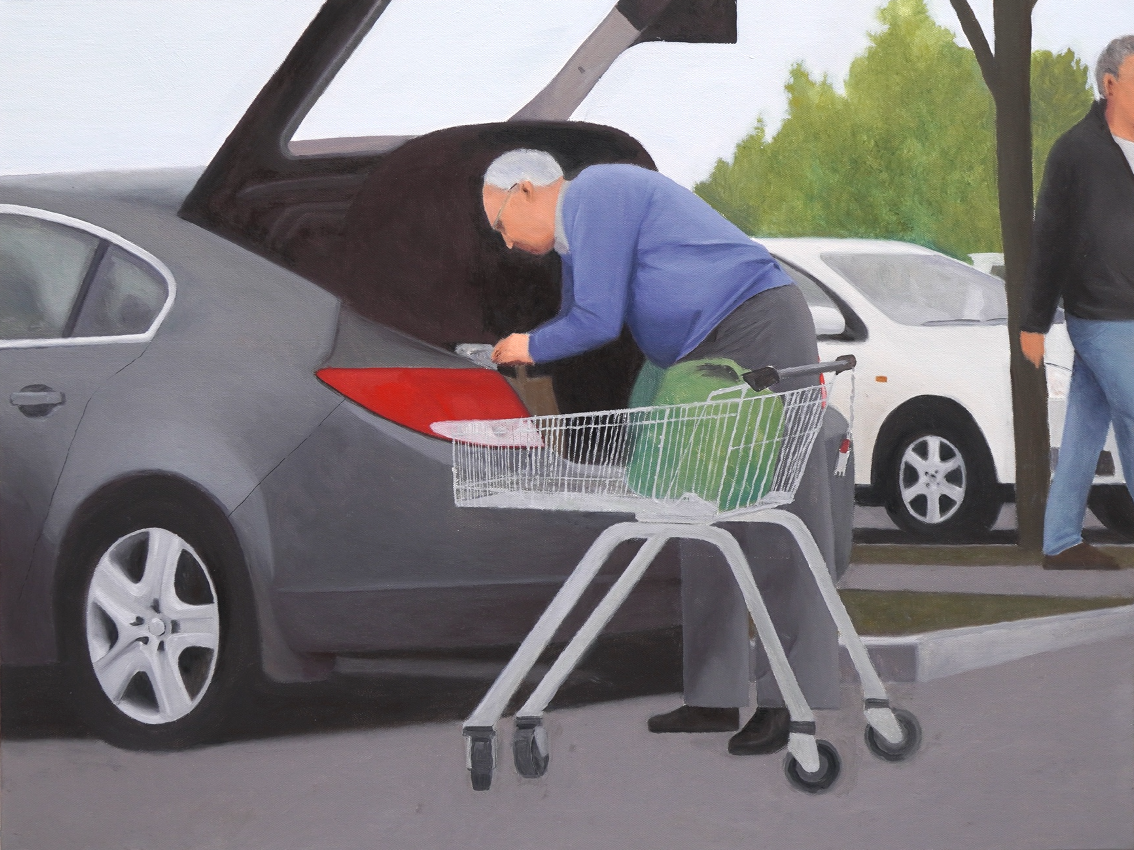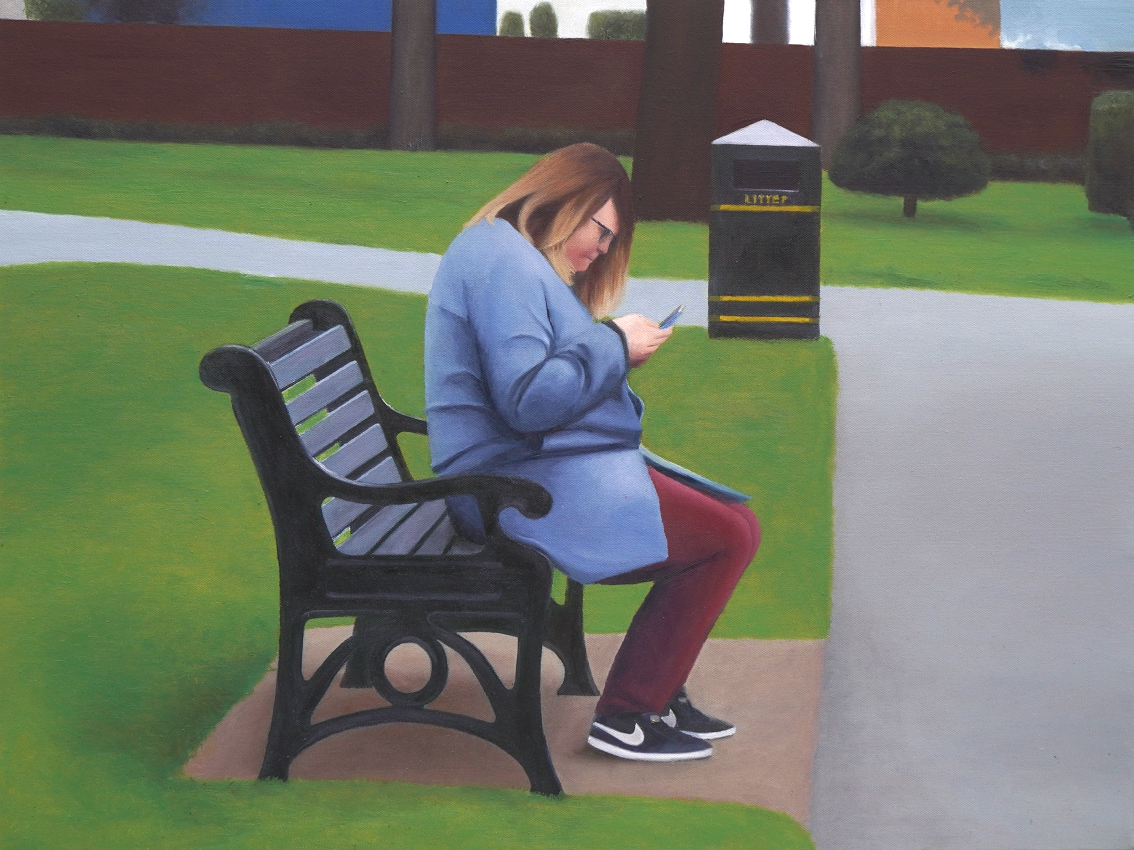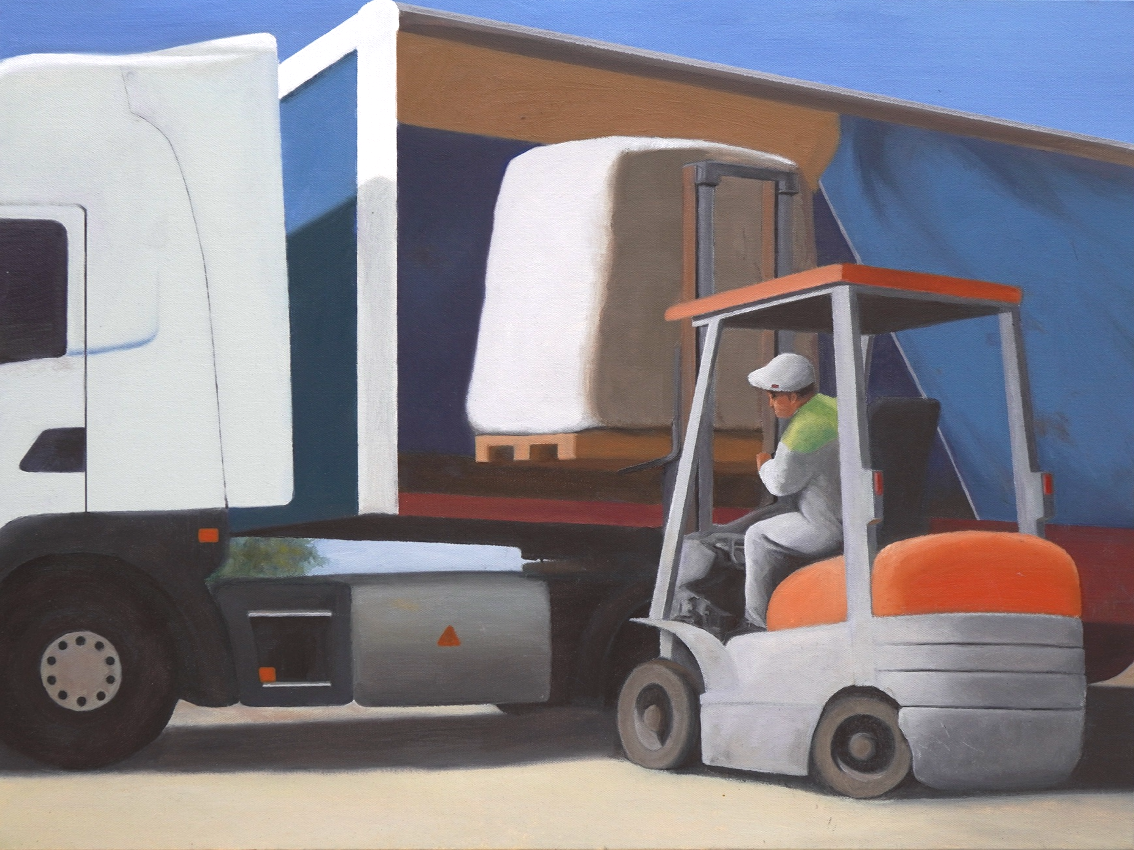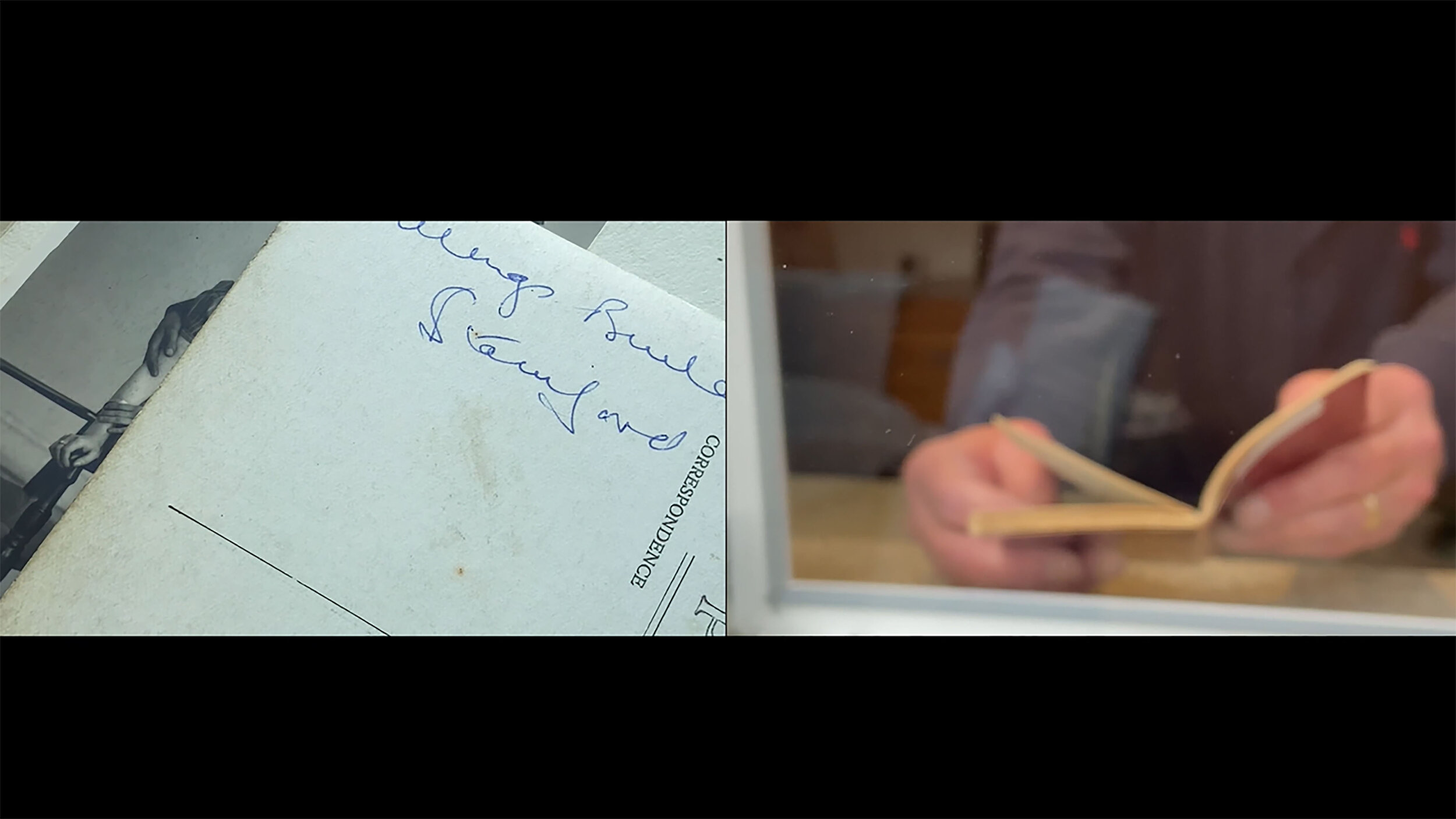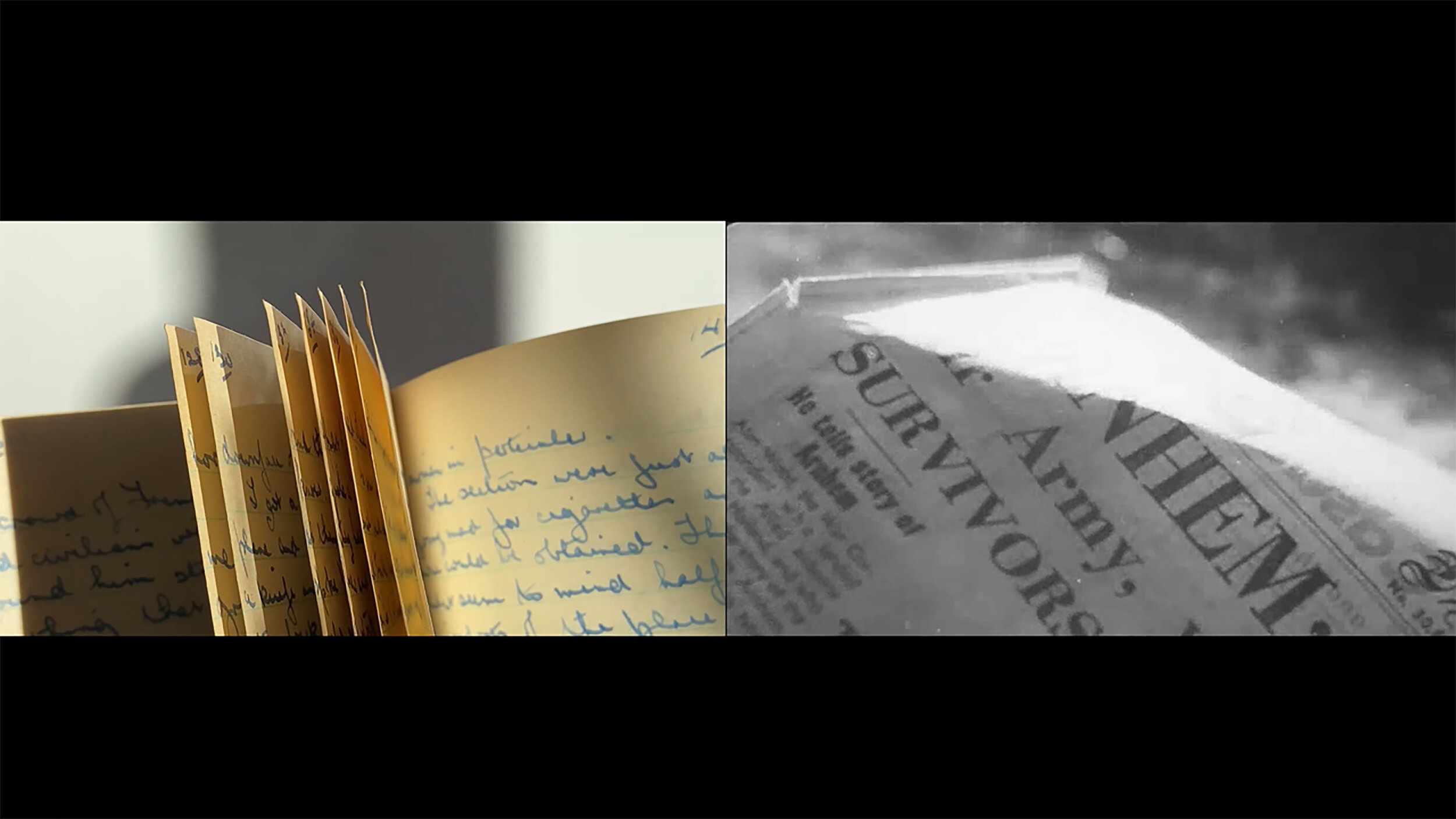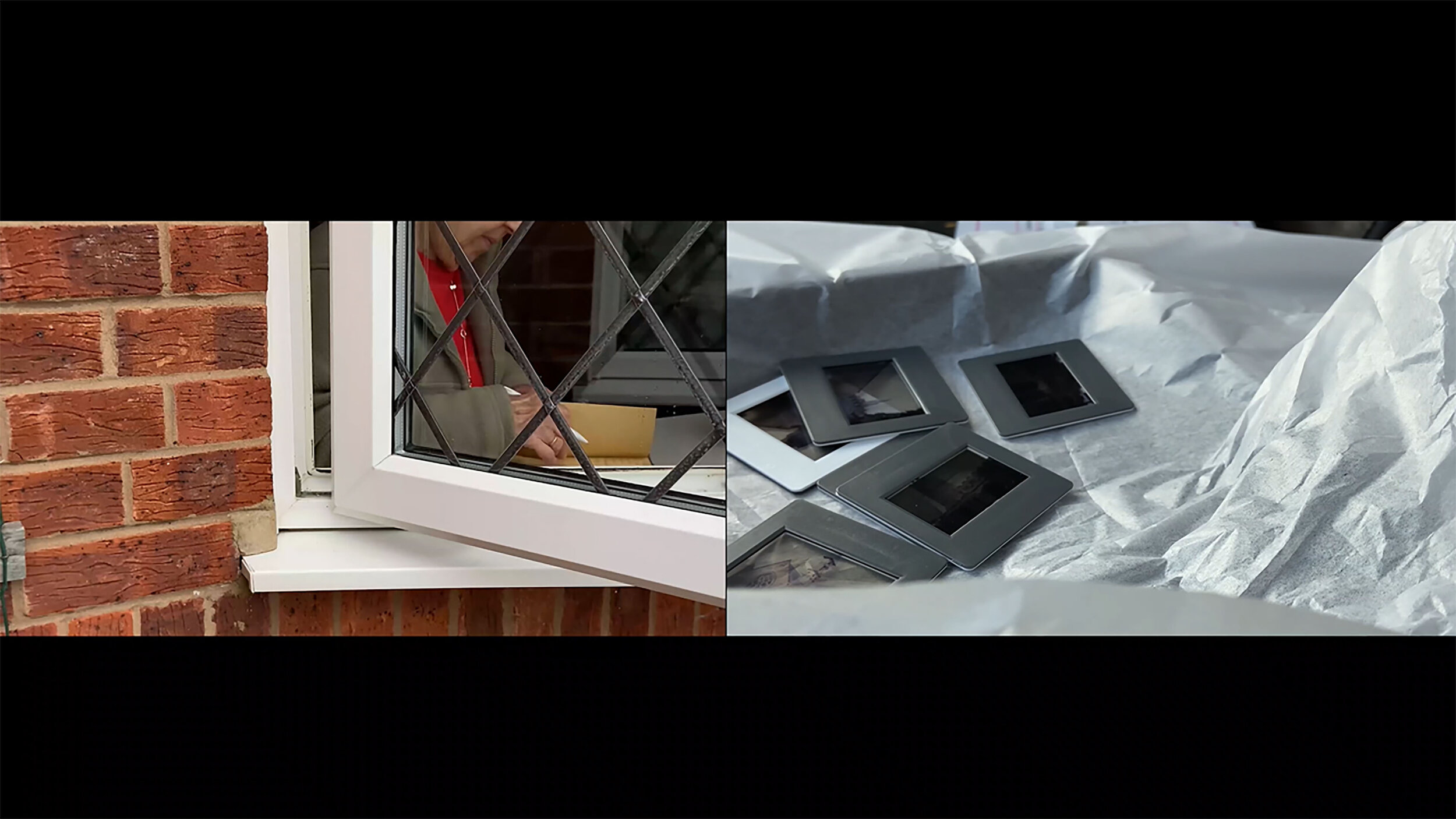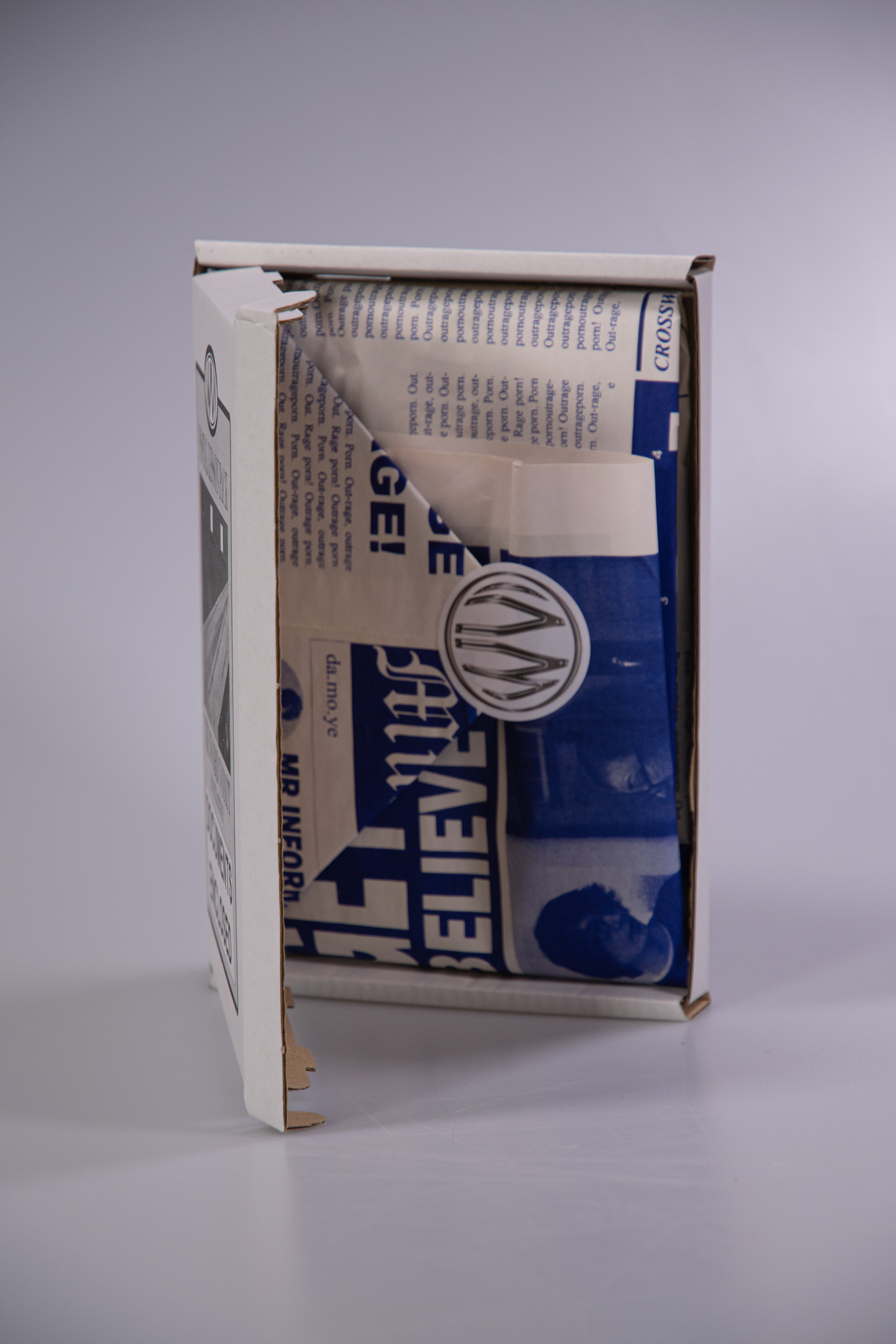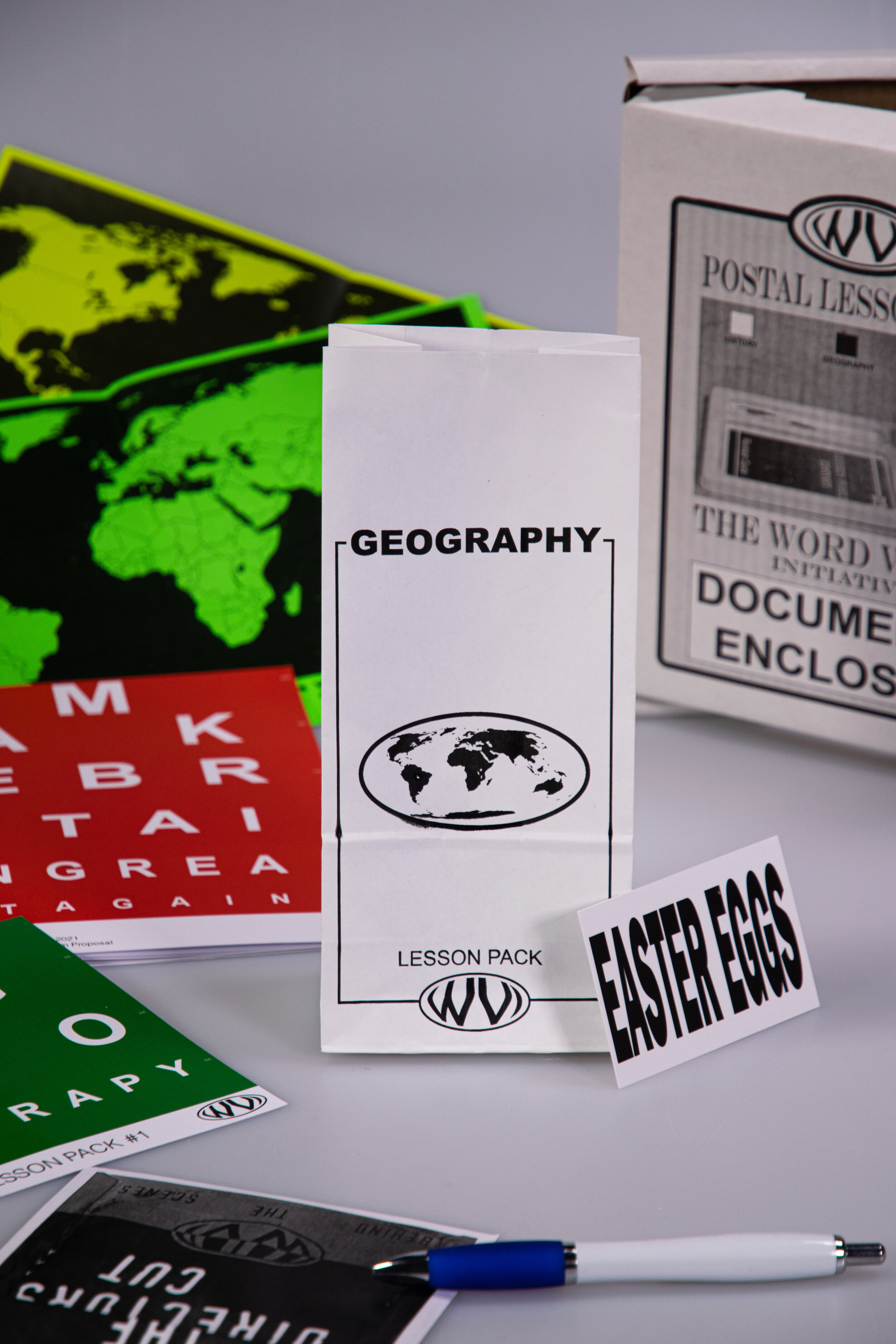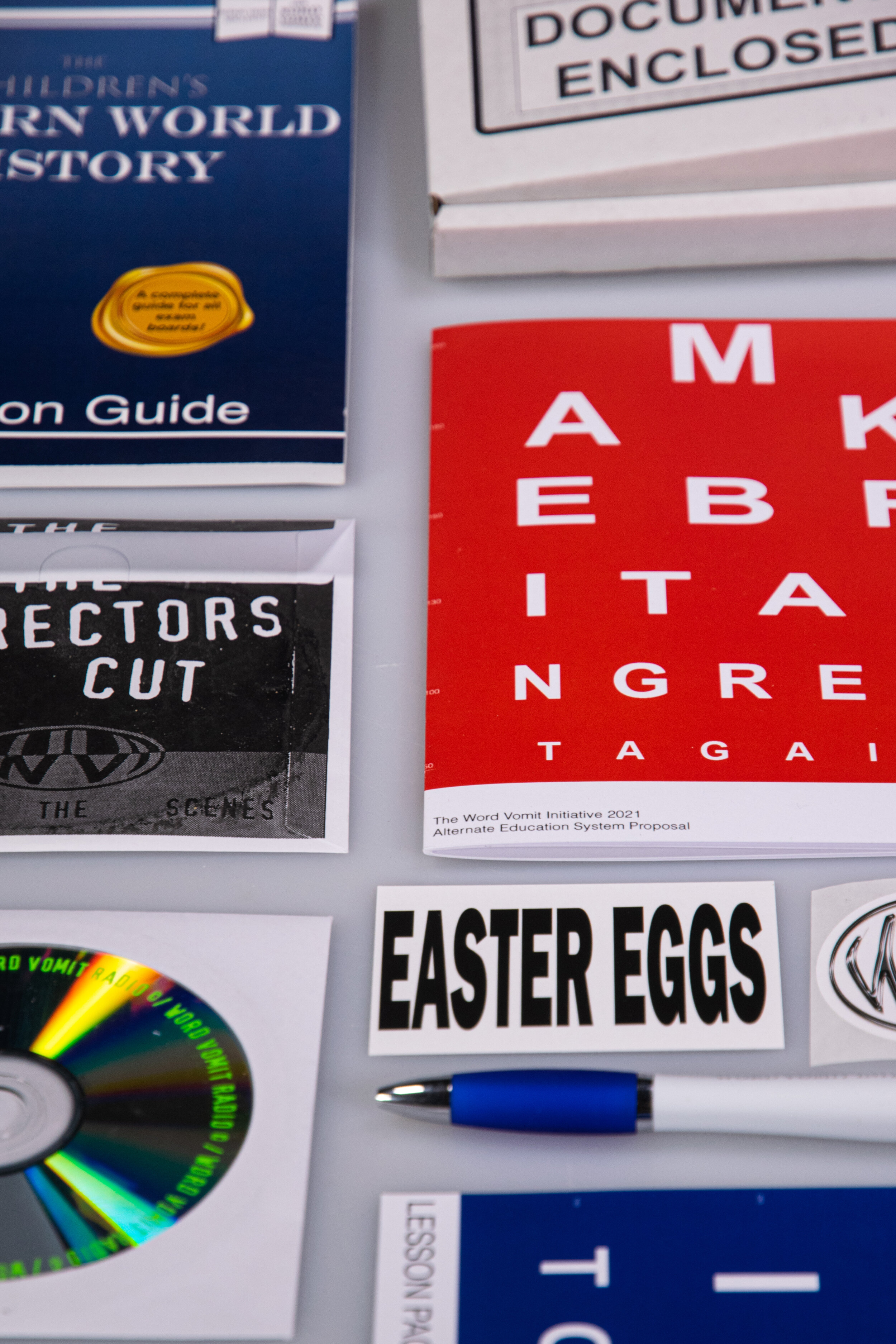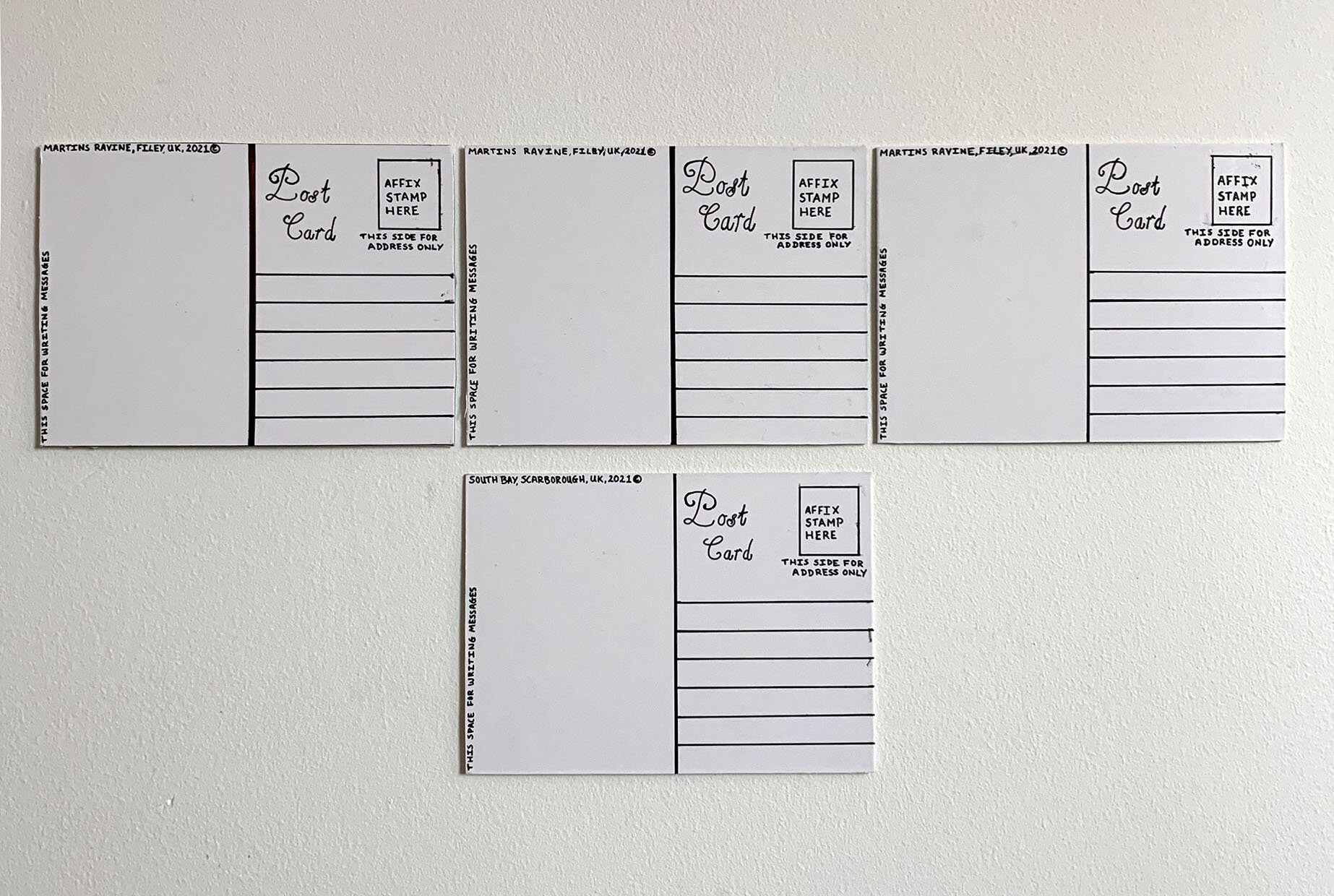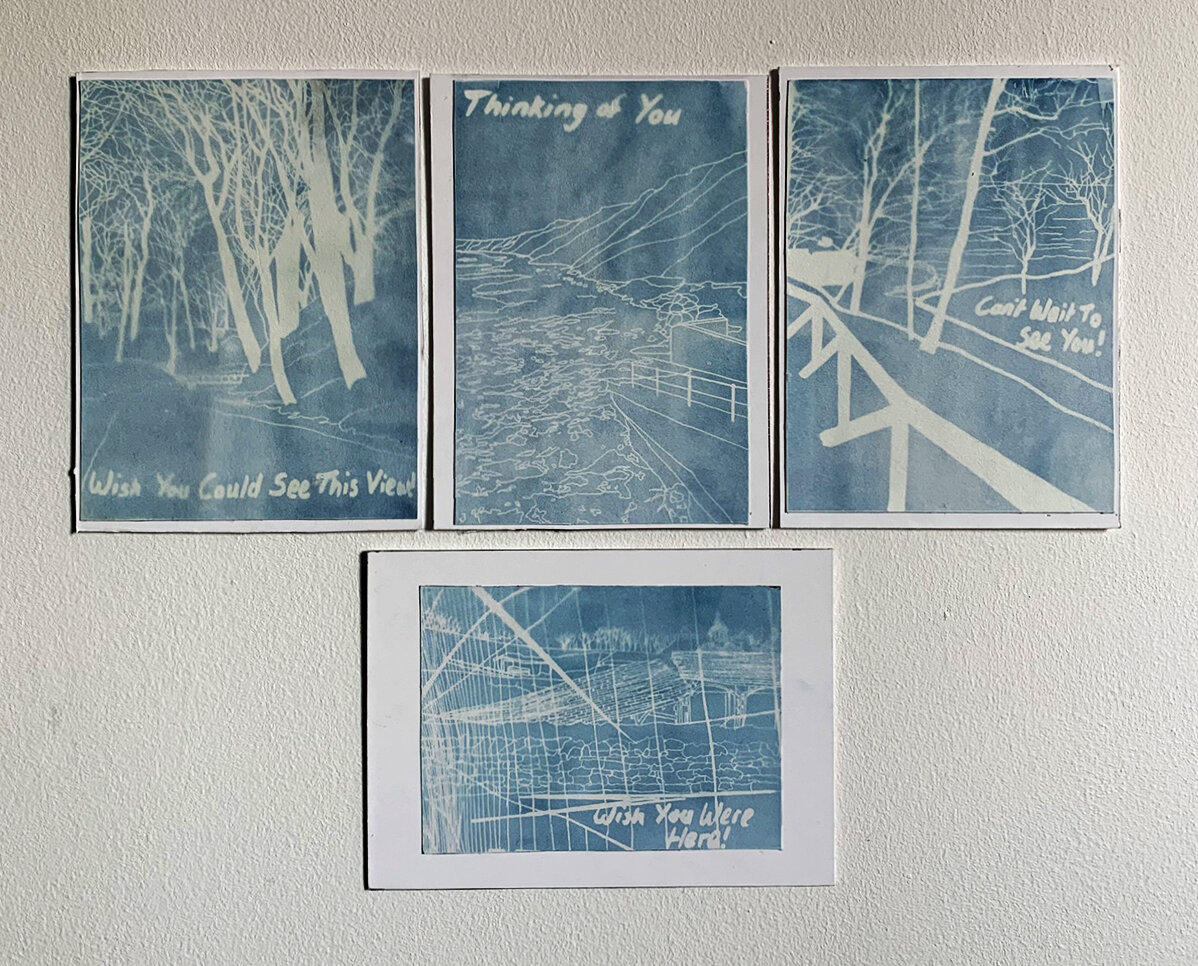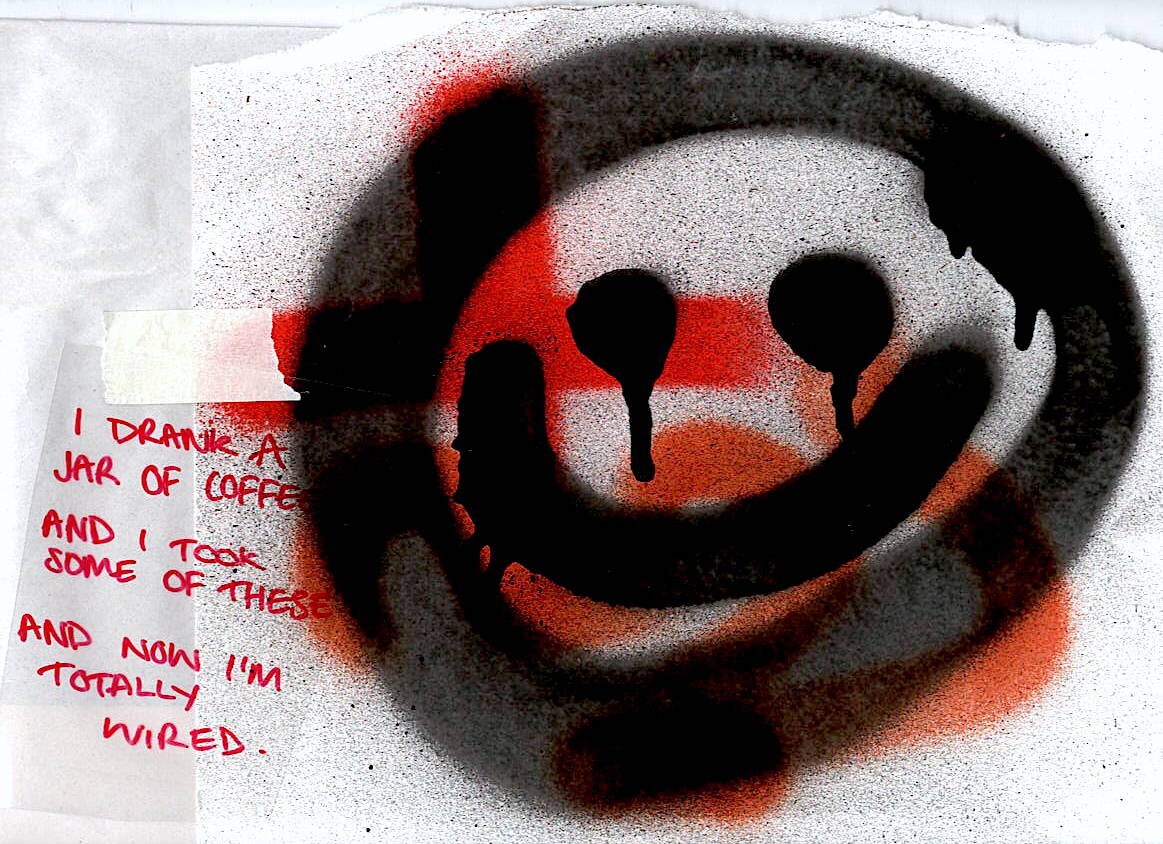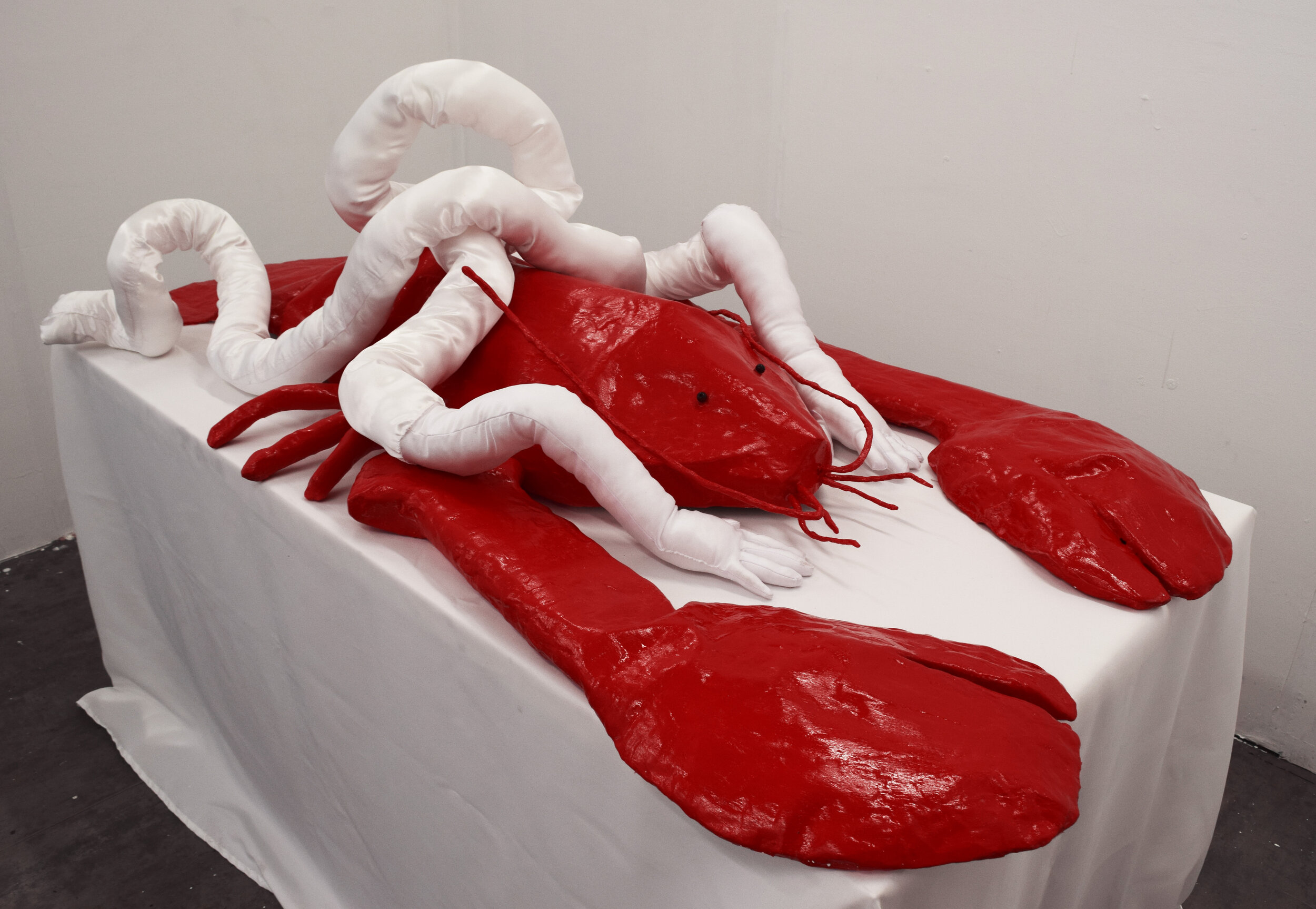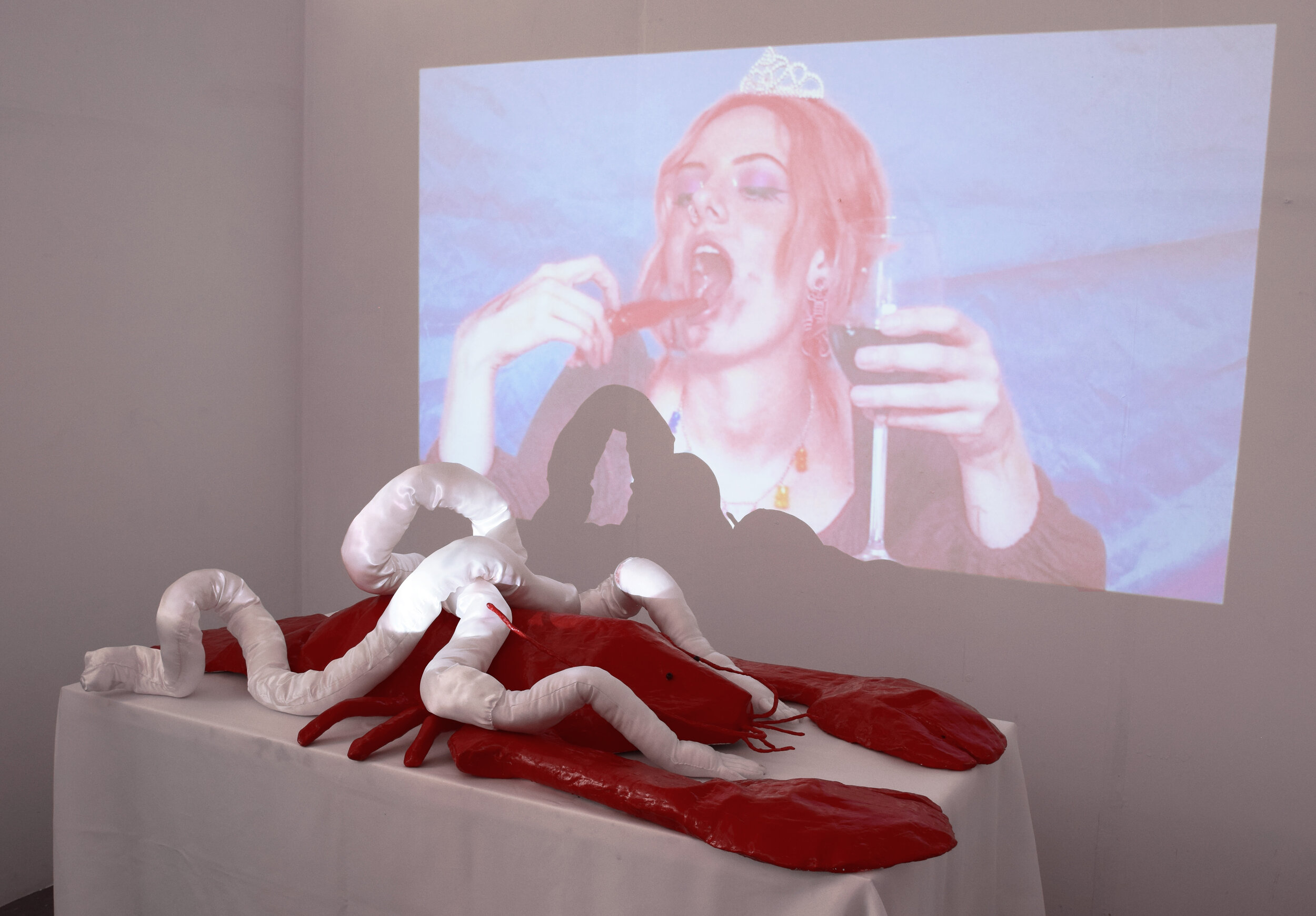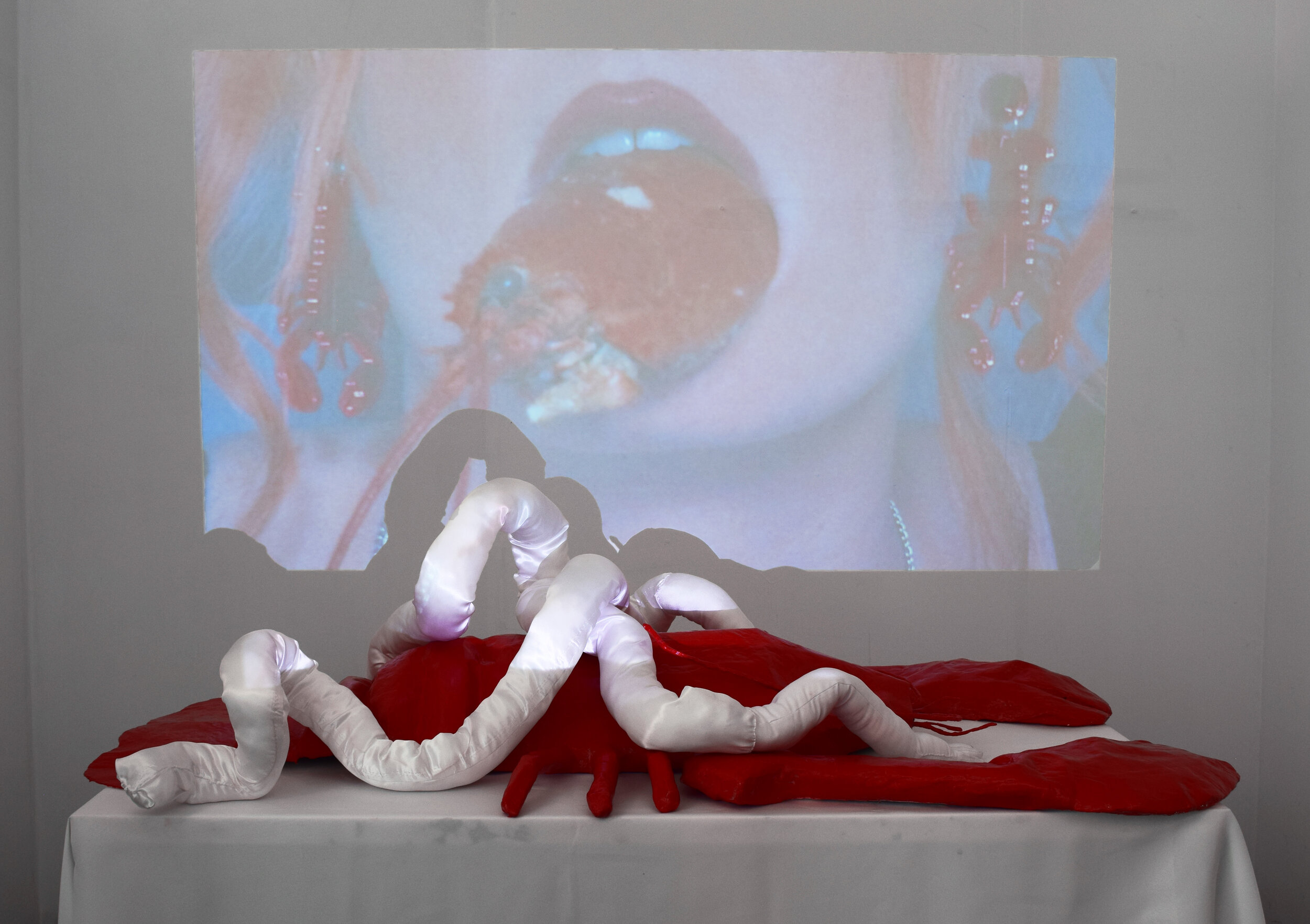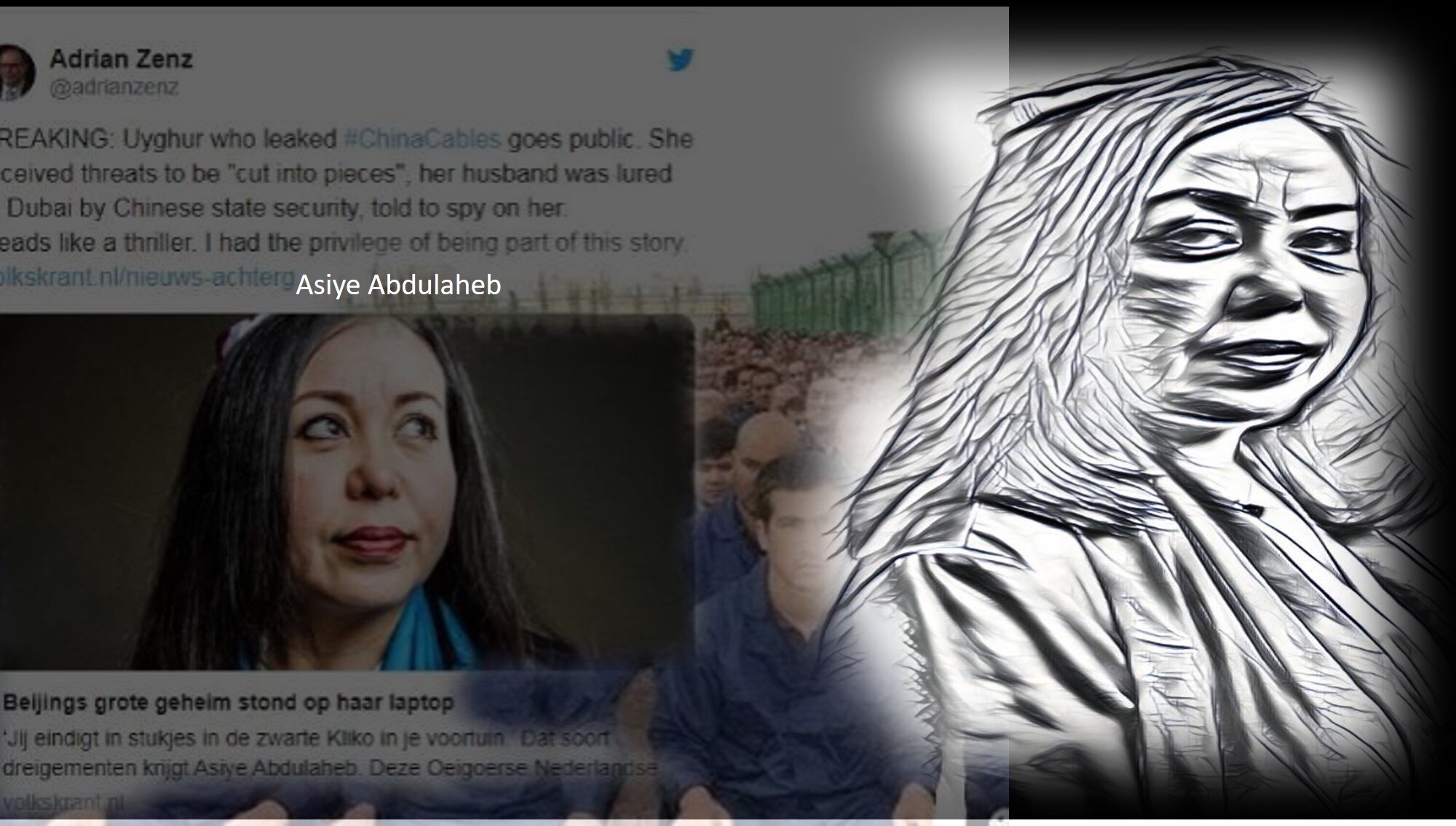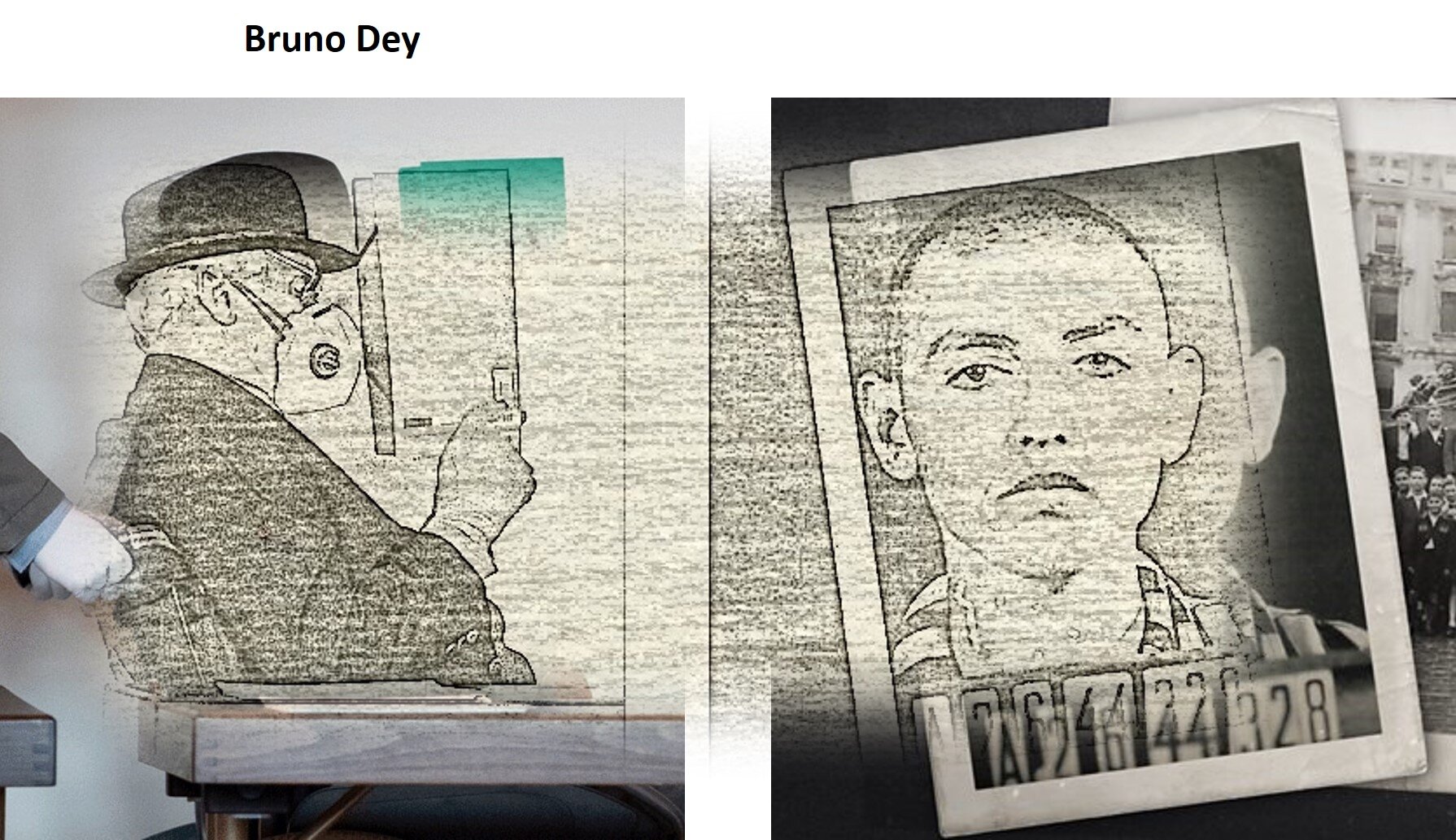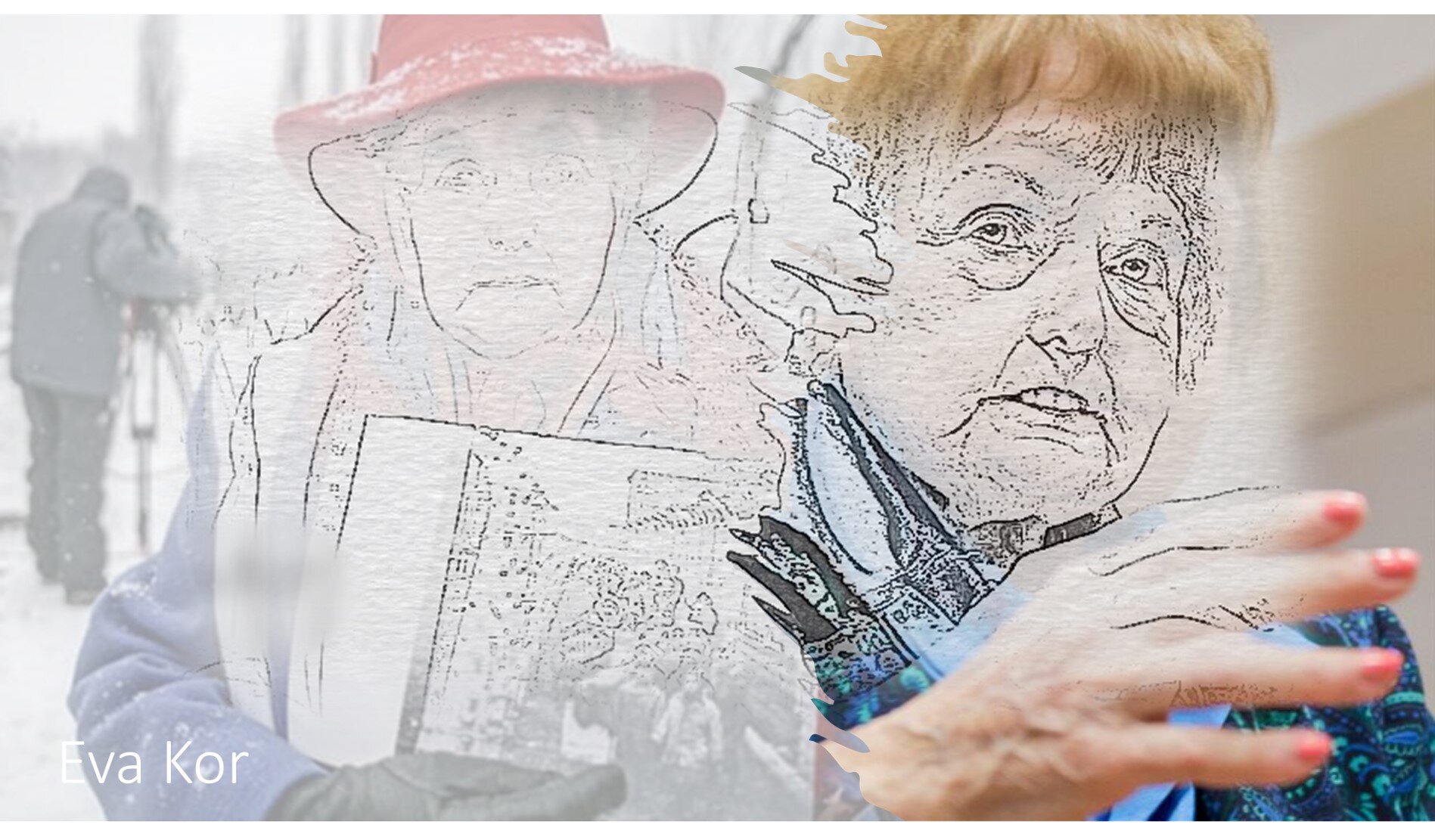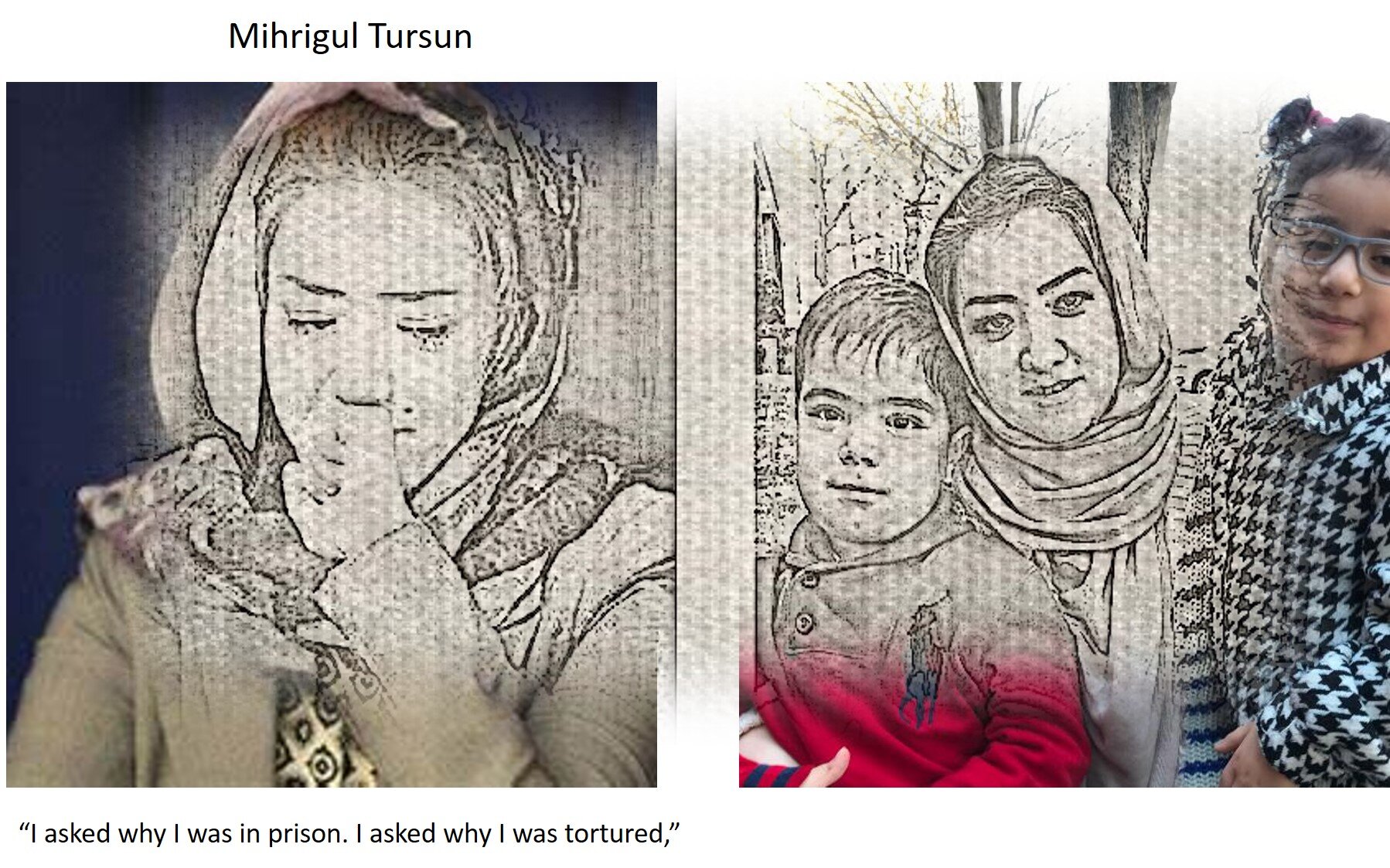Refracted Realities
10 May - 13 June
Online Exhibition
Emily Kempster
Victoria Andrusyschyn
Thomas Marriott
Petros Nikolaou
Beth Cummings
Elicia Agar
Emily Butler
Katia Greenwood
Sophie Turton
Molly Anderson
Liv Jenks
Natassja Drobinski
Ammaarah Nazir
Kirsty Noble
Refracted Realities is one of four online degree shows by third year Fine Art students at Sheffield Hallam University.
Living in critical and isolating times also means living with an urge to understand where we are and how we got here. In this online exhibition, the artists turn to modes of daily survival in varying scales: from diasporic memories to pop culture, environmental catastrophe to nationalism.
More information about the artists can be found towards the bottom of the page.
Description automatically generated (with low confidence), two-channel video installation
Emily Kempster
Top (gallery): The Ukrainian Dancers, acrylic painting. Series of two, 90cm x 70cm and 100cm x 60cm
Bottom: Hustka, acrylic painting, 40cm x 50cm
Victoria Andrusyschyn
Agency and the Everyday, oil on canvas. Series of six, each 60cm x 80cm
Individual titles: Angling, Art Gallery, Smoking, Unpacking, Woman on her Phone, Forklift
Thomas Marriott
Top to bottom:
Aftermath, painting and a pair of army boots. Painting 120cm x 100cm
Never Forget, mixed media wall piece and footprints on the floor. Painting 200cm x 100cm
Finding Hope, mixed media wall piece and suitcase. Painting 200cm x 130cm; suitcase 84cm x 50cm x 50cm
Petros Nikolaou
Page 6, two-channel video installation
Beth Cummings
THE WORD VOMIT INITIATIVE, alternative lesson packs
Elicia Agar
Your chances of being alive are 1 in 400-trillion, digital image
Emily Butler
Top: Razed and Replaced, video
Middle: Goodbye Hometown, digital collage, 21cm x 29.7cm
Bottom: Making Homes - Leith Banana Flats, video
Katia Greenwood
Wish You Could Prevent This, print and drawing
Series of 4, each 14.8cm x 10.5cm
Sophie Turton
Top:
Are U Dancing?, video
Bottom, left to right:
Night In, digital collage, 30cm x 22 cm
You don't have to be an American to be strange, digital collage, 30cm x 21 cm
Molly Anderson
Enid Simmons, oil painting, 150cm x 100 cm
Liv Jenks
The fat cat who came to tea, installation with video and sculpture
Natassja Drobinski
Holocaust vs Xinjian contraction camps
Ammaarah Nazir
The Last Catch, oil and pastel on hand dyed cotton, 100cm x 140cm
Kirsty Noble
Emily Kempster
Primarily my practice is based around experimental methods of questioning the way we perceive the everyday at its most basic and mundane levels. My concerns are based around the environment and what objects can constitute as valuable in the ways of art as objects and how a person can relate to art.
This light and sculpture based installation stemmed from the beginning of the Covid-19 pandemic in England whereby the information given to the public was excessive yet still inaccessible, and how we as a society we became so quickly reliant on the digital and AI without much of a second thought. Materiality is a vital part of this installation as I consider each objects distinction and recognisability as able to provoke histories to the film and sculpture, possibly suggesting a sense of unease in the otherwise ordinary objects.
Victoria Andrusyschyn
Victoria Andrusyschyn is a painter originally from the UK whos Ukrainian heritage and culture influences her daily life and the work she creates. Brought up surrounded by her Ukrainian family and the language, music, dance and colours of the culture, she uses her heritage as a means for inspiration in creating her paintings. She uses painting as a technique to find physical ways to connect to and manifest the ties to Ukrainian civilisation, which are not present in her British, day to day life. Victoria uses her experiences as a Ukrainian dancer, which she takes great pride in being a part of to showcase the richness and beauty of the culture by using acrylic paint to depict the materiality of the traditional dance costumes, as well as the movement of the dancing figures. Precision is an important aspect in her artwork, ensuring every brush stroke creates a meaningful and personal link to who she is as an artist. The paintings she displays in this exhibition explore one aspect of the culture, the Ukrainian dance, which has been a hobby of hers from a young age, using her friends who dance alondgside her as models to showcase the vibrant and skillful aspect of the Ukrainain culture.
Thomas Marriott
My practice is concerned with Everyday Life and the familiar, and I use painting and drawing to explore visual themes which point towards a sense of narrative in our lives. Many recurring themes inform my work, such as ritual, popular culture and nationhood, and I use these motifs as prisms to look at the familiar in new ways. Recently, I have begun to explore the processes of image gathering and image making as new fields to confront ‘Everydayness’. Increasingly, visual metaphor and an assertive painting style are driving my practice forward.
My series ‘Agency and the Everyday’ addresses the personal and societal forces acting on us all, and shows the intersection between decisions, habits and obligations in our civic life. I use stock imagery to lend the paintings an almost surreal quality.
Petros Nikolaou
I was asked to give a definition to my art but how can someone give a definition to art? In a simple answer, my art is the spiritual journey during an emotion or an action. Each one of my paintings is a translation of certain emotions throughout my life's experiences. Art for me is everywhere and limitless.
Every little thing in our everyday life, outside of the typical gallery space, is what fuels my inspiration. Strong and soft brushstrokes, a range of materials, a huge color pallet, and many other techniques are the ingredients to express myself through my art. An important tool that helps me find inspiration is my personal experiences but also, the stories told by the people close to me. Unforgettable stories, marked in my memory. Stories like the ones told by my grandmother and the time her whole family had to leave their home and all their belongings behind, as a result of war. During the storytelling, emotions like sadness, fear, pain, and depression become part of you while changing you.
This series of three pieces of work are based on these stories. The viewer should interact with the pieces on the floor to make all these emotions understandable.
Beth Cummings
Cummings’ practice explores how the lost memories of her family can be narrated and translated through the research of the archive. By using the medium of video, she captures a contemporary take of historical anecdotes told from the perspective of her Grandparents. Cummings takes the viewers through an enveloping experience, where she mimics the archival processes taken to uncover these narratives. From analysing conversations, photographs, diary extracts and film, a textural, sensory space is created to share her interest in materiality.
Page 6 (2021) introduces the audience into an inviting, educational space with a 2- channel screening. The audience engage with the second-hand narratives on screen, where they begin to learn the historical accounts about her hometown in Stamford, as well as diary extracts taken from her Great Grandad’s personal WW2 diaries. This immersive installation combines how information is gathered through conversation with her Grandparents, whilst also demonstrating the difficulty of communication during the pandemic. In some scenes, the camera becomes Cummings’ contemporary set of eyes, in which she examines creases, folds and blots that lie on the surface of such historical materials. Other sections return to the Imperial War Museum’s archive, leaving a contemplative space for when memories cannot be recreated. Cummings shares such a heartfelt relationship to her Grandparents and wanted to dedicate her work to them, to show how their characteristics and narratives impacted her understanding of life. This leaves the audience to engage and reflect on the personal, intimate slice of the artist’s life.
Elicia Agar
Elicia Agar is a Fine Artist working with design-based practices. One-woman factory. The Word Vomit Initiative is a faux corporation allowing Agar to explore themes of UK nationalist rhetoric, press bias and polarization, marketing strategies, consumerism and most recently the idea of a curriculum reform.
For this piece, Agar began by conducting research with 60 participants, went on to write an educational manifesto, and from this produced a range of lesson packs to be delivered to the home. Each pack contains educational resources, a copy of the manifesto, a Word Vomit Radio CD, plus corporate gifts. Available on wordvomitinitiative.com.
Emily Butler
My artwork looks into aesthetics & visuals that manage to elicit a sense of enjoyment and fun. With a deep love of the camp sensibility & kitsch visuals I wanted to create works that explored the artificial/gaudy but also captured a sense of theatre and excess.
My works investigate how materiality, advertising and retro tech can create that enticing & indulging sense of joy; we all need to disregard shame and be a part of something completely pleasing.
‘Your chances of being alive are 1 in 400-trillion’ is a reminder that us just being here is already against the odds, so we might as well enjoy it.’
Katia Greenwood
This collection of work focuses on creating a dialogue around social housing and its multifaceted nature. I feel that in the artistic community, and wider media, social housing is polarised on a spectrum, either a romanticised brutalist aesthetic or a crumbling eyesore waiting for demolition.
My practice is focused on the creation of an archive of pieces, highlighting community and emphasising the importance that these buildings be viewed as homes and community spaces, not just brutalist monuments to be romanticised or dilapidated structures to be discarded and demolished.
My work ‘Razed and Replaced’ focuses on contrasting collage style archive footage with a textured spoken word soundtrack pulling inspiration from the politicisation of spoken word, collage and a focus on community and working class culture.
In contrast to this ‘Making Homes’ is a gentle protest against the demolition of so many of these blocks. A quiet rebellion against the demolition of blocks where, instead, they are built. This piece intrinsically links me, the artist, with the process of social housing development. It asks the question ‘what makes a home?’ confronting the viewer with their own bias and predisposition around the idea of homeliness.
My practice is very multidiscaplinary and ‘Goodbye Hometown’ is just one example of this organic development. Unlike the film pieces, it is a way to draw the viewer in, and rather than suggesting an angle or viewpoint the digital collage lets the viewer reminisce in the nostalgia of place and the melancholy of leaving your home.
Sophie Turton
The primary issue I aim to combat within my practice is – What impact are you having upon the environment? In recent years it is becoming increasingly evident that the actions of the human population are continuing to affect the environment we live in, and adding to the issues of climate change. Within my practice I use primarily 2-Dimensional mediums in the form of paint, photography, and prints to bring home the harsh realities of the world we will come to live in if we continue to disregard care for the planet. There is a need for more work to be done in helping the environment, through my works I aim to raise a question within the onlooker – making them question if they can improve their own actions. Can you recycle more? How about not throwing your litter on the floor? Simple actions can in the long run prolong the life on the planet we call home, as well as aiding the survival of other plants and animals. Art practices have and continue to pave the way for environmental change – my own work adds to this through the series ‘Wish You Could Prevent This’. Exhibited as a homage to the traditional postcard, the cyanotypes portray the view which will adorn our postcards of the future if we don’t change our ways.
Molly Anderson
Influenced by my childhood and adolescence in Nottingham, I take inspiration from creativity born in the city, the mundane and the everyday. My recent work has been exploring English culture and identity, I want to open a dialogue into what contributes to an English identity and any sense of pride. I work with collage, text, photography and video depending on what feels best to make sense of the world around me. My sources are a combination of autobiographical stuff, with the opinions and ramblings of others and pretty much anything I consume. I make my work in response to the things I discover, informed by both my own experiences and unavoidably larger socio-political issues. Ideas born from frustration or a wish to learn more tend to be what my work centres around, it is a scrapbook of thoughts, ideas and discoveries, a never-ending attempt to piece together the mystery that is English culture.
Liv Jenks
My practice focuses on our society's growing relationship with digital and virtual platforms to explore how this has changed the distinction between private/public sphere, communication and language, the way we are sharing images and how we present as individuals through this online sharing. Consisting of still life and figurative paintings that is greatly supported by photography; my work aims to create narratives containing metaphors and satirical statements that act as a looking glass into my own observations and relationship with these ideas.
This particular piece “It matters when it’s cold outside” is directly exploring the fetishisation and objectification of queer relationships within online image/video sharing platforms; fueled by observations of these interactions and my own personal experiences as a queer woman in a relationship.
Natassja Drobinski
The fat cat who came to tea is a visual exploration of the dark, surreal world in which glamorous billionaires exist, and the artist’s own relationship to class. Natassja Drobinski has utilized visceral and playful sculptural shapes to explore current political issues such as the wealth gap and food poverty through playing with ideas of greed, gluttony, and avariciousness. The installation also features the video piece A pretty shit dinner party in which the artist consumes a lobster in character. The voice over for the video was written by screenwriter Matt Gawronski.
Ammaarah Nazir
I am intent in discovering art which can express feelings using expressionism and contemporary art. My focus in my work which I had produce was to hold signification to anecdotes of what is the current situation in china and by using art in producing something which can tell the story behind what has been happened with the innocent Uyghur Muslims in the Chinese concentration camps in china.
My aim behind my work that I have produced is to attract the audience’s attention towards the purpose of my work. Throughout my practice currently I have been investigated into the medias feedback on to the Chinese concentration camps and the treatment that the Uyghur Muslims have been suffered, then looking back at history of the holocaust on how the Jews were treated by the Nazi party in Germany during the holocaust and world war 2.
The approach of my series of works are to narrate stories of both holocaust and Chinese concentration camps.
Kirsty Noble
“What interests me is loss, and how we navigate it. There is monumental potential in grief; to reflect, adapt and change both collectively and personally. In terms of the ecological and environmental crisis, this is grossly entangled with guilt and often denial. The paintings are a raw processing of this turmoil in hope of a better future.”
The Last Catch depicts children playfully fishing in a stream. It is an image of innocence and nostalgia, of ‘simpler times’. It’s fabricated origins as a collage point towards the
increasing dissipation of these experiences due to the far-reaching effects of unsustainable manufacture processes of the textile industry.
The painting is the first in a series that depicts varying aspects of Ecological Grief. The use of artificial pigments and bright ‘foreign’ colour contrasts against the serene landscape, referencing the offensive harsh chemicals often used in textile finishing.
Drawing from Albrecht’s Solastalgia (2005), the felt trauma of losing one’s sense of home through environmental degradation, the work points towards the inequality of this damage; questioning who is paying the highest price and who is making the most profit. For those who work in these factories, live in these places, and fish in these waters; Solastalgia is exacerbated by a sense of powerlessness or lack of control over the unfolding change process.
By unveiling its blue hand-dyed foundation the artist brings into question their own culpability and guilt associated with sustainable choices - raising the issues of power and freedom. Calling consumers to capitalise on their power over the fashion market and make sustainable conscious choices.
